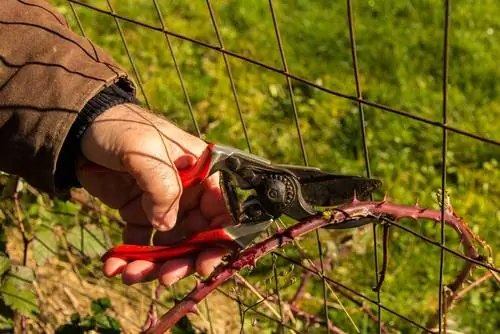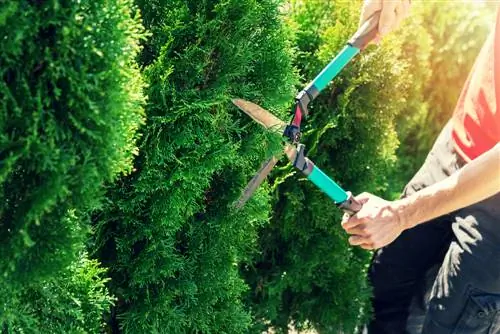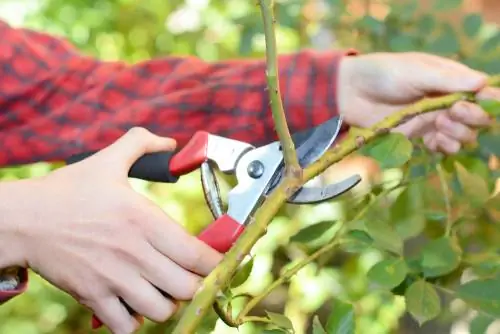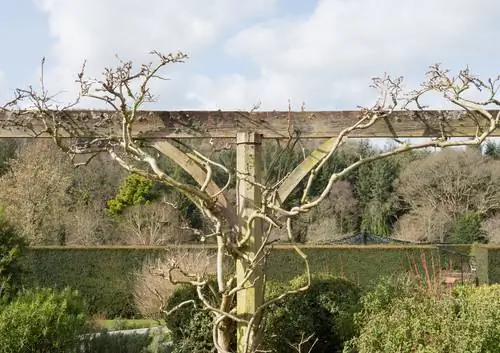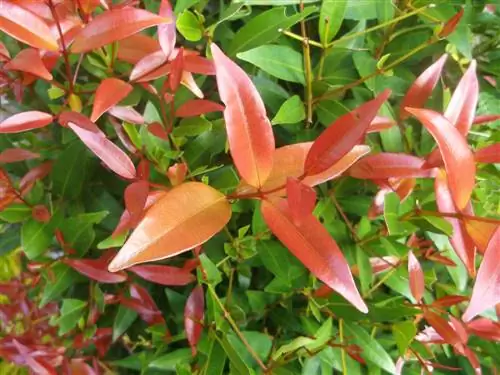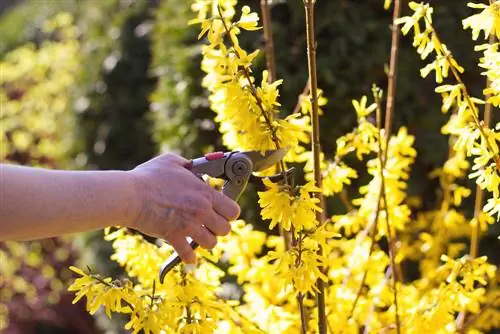- Author admin [email protected].
- Public 2023-12-16 16:46.
- Last modified 2025-06-01 06:02.
Summertime is blackberry time. The tart-sweet harvest season extends from July to October. Of course, this applies under the premise that you have taken care of the cut in a timely and competent manner. This tutorial will familiarize you with all aspects of the correct pruning of blackberry bushes.
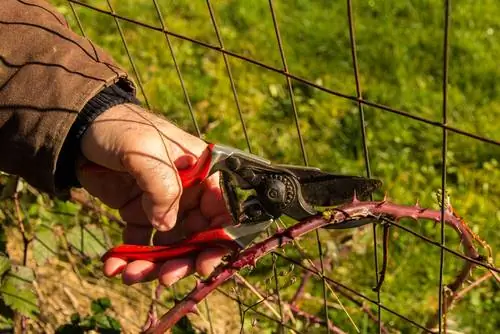
How should I cut the blackberries?
Prune the blackberries in the second year. Shorten flowers and side shoots. The optimal time for pruning is in February or March. The blackberries will then sprout again. Remove the old vines every year and attach new vines.
Where do the berries appear?
Pruning blackberries is easier to understand if you are familiar with the specific growth characteristics. We therefore invite you to take a short excursion into the botanical peculiarities of our oldest local berry bushes. This is how blackberries grow, bloom and fruit:
- Up to 5 meter long rods with and without thorns (botanically correct: spines)
- Growth of long tendrils in the first year
- Slow-growing varieties with unbranched tendrils, strong-growing varieties with short side shoots in the first year
- In the second year, long side shoots along the tendrils with terminal flowers from May to August
- Black blackberries from July to October
Worn fruit canes die in winter. This feature simplifies the pruning care of blackberry bushes. The biggest challenge for the gardener is distinguishing between young, future fruit canes and worn tendrils. A single bush is sufficient to harvest juicy blackberries because the berry trees areself-fruiting.
Cutting options and dates
Pruning blackberries has two goals: removing worn canes and promoting young tendrils for this year's harvest. Since even weak, thornless varieties grow up to 100 centimeters annually, you cannot avoid annual, consistent trimming. The scissors ensure order in the berry bush the year it is planted. In the following years, a courageous approach is important so that the growth rockets do not grow over your heads, shade each other and young fruit wood fails due to a lack of light. The following table summarizes all cutting options with recommended dates:
| Cut option | Goal/Occasion | best date |
|---|---|---|
| Plant cutting | orderly training on a wire trellis | after planting |
| Conservation cut | thinning out worn canes, promoting young fruit wood | February to early March |
| Summer cut | Prune miserly shoots, remove excess tendrils | End of July |
| Column cut | Mix upright blackberries | February to early March |
Planting pruning with espalier training
Prickly blackberries have had their day in the home garden. American premium varieties such as 'Thornless Oregon' or 'Navaho', which do not have a prickly thorny layer, are very popular. Instead, the new favorites in the orchard delight with strong growth and large berries. Since pruning care largely depends on your ability to distinguish betweenone-year-old and two-year-old tendrils, the following espalier training ensures order in the blackberry bush right from the start. This is how it works:
- The best time for planting is in spring (March to April)
- Set up a wire trellis at the location, 6 m long and 3 tension wires at 50 cm, 100 cm and 150 cm high
- Plant the young blackberry plant in the middle in front of the trellis so that you can later arrange the tendrils according to age
- Care: cover buds close to the ground with soil at least 4 to 5 centimeters high
- After planting, cut back all tendrils to 30 to 40 centimeters
- Place the scissors at a short distance from a leaf or shoot bud
- Select the best canes during the spring (2 to 3 strong-growing varieties, 5 to 10 weak-growing varieties)
- Cut off all remaining tendrils at ground level
Less space-consuming varieties, such as the slender 'Navaho', make do with a shorter wire trellis of 3 to 4 meters. It is important to note that there is enough space on both sides so that you can tie the long tendrils alternative to keep an overview.
Tie the selected fruit canes parallel to the growth on the wire trellis horizontally to fan-shaped to the right or left. Your blackberry will bear its first fruit next year on these tendrils. The opposite side initially remains ungrown during the planting year. This place isreserved for the young vines, which grow in the second year and fruit in the third year.
Tip
Thorny blackberries tend to grow strongly with runners. If you have chosen a classic blackberry variety, such as 'Theodor Reimers', as a precaution, line the planting pit with pond liner as a root barrier. It is completely sufficient if the exclusion zone extends to a depth of 30 centimeters. Blackberries thrive as shallow-rooted plants.
Reciprocal education and maintenance pruning
In the private cultivation of blackberries,mutual training has proven to be excellent because it does not raise any questions about what should and should not be cut in February. Therefore, continue the recommended training method as initiated in the year of planting. This is how easy it is to complete the pruning care of blackberries for a rich harvest:
- The best time is in February when the sky is overcast and temperatures are above freezing
- Cut off worn rods from the previous year at ground level
- Prune side shoots along last year's tendrils to two to three buds
Now mutual education benefits you. On one side of the trellis are the worn-out, largely dead tendrils that gave you delicate blackberries the previous fall. On the opposite side are the now two-year-old canes, whose side shoots will bloom and bear fruit this year. Shorten these side shoots heavily, because they will grow rapidly in length until the flowering period begins.
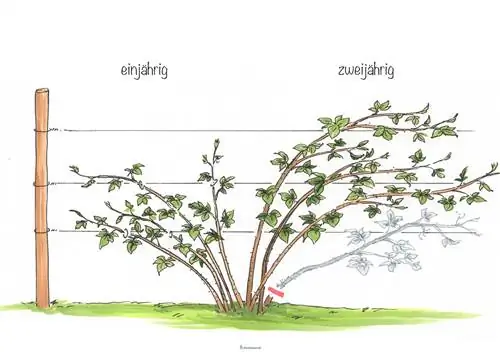
Tie one- and two-year-old canes separately to the wire trellis. Cut off the removed canes from the previous year at ground level in February. Cut the side shoots on last year's vines to short stubs with two buds.
Do not cut blackberries after harvest
Please don't be tempted to cut your blackberries immediately after harvesting in autumn. Undoubtedly, this is the easiest time to identify which rods to cut and which not. As with all shrubs, your blackberry will sprout happily after pruning. This late in the year, the fresh shoots can no longer ripen in time and have no resistance to the first frosts. In the worst case scenario, the berry bush freezes back completely and no longer sprouts the next spring.
The onlyExceptionfor autumn pruning applies tomild winter regions, such as on the Lower Rhine, along the Moselle, Ahr and Neckar. Where the thermometer does not drop below -10 degrees Celsius in winter, a blackberry bush can cope with late pruning.
Excursus
Cutted blackberry canes hold valuable life
In the natural garden, worn blackberry canes are not disposed of carelessly. The long tendrils often serve as a nursery for wild bees for their larvae. Please do not cut the shoots into pieces, but leave them at their natural length if possible. Bundle the cuttings and store them in a sunny pile of dead wood. This allows the larvae to mature in peace and, as adult wild bees, to work diligently in pollinating your ornamental and crop plants. If you care for a Benje hedge, thinned out blackberry tendrils are an ideal component. In the cottage garden, the flexible rods are simply braided into a picket or hunter's fence.
Summer pruning - maximizing blackberries
On fast-growing blackberries, pruning in late winter is not enough to prevent the berry bushes from forming confusing bushes. When this year's tendrils sprout from the rhizome,lateral stingy shoots These are barren, lushly leafy shoots that cast shadows on flowers and fruits. By thinning out a blackberry bush in summer, you promote flower abundance and fruit yield. Excessive, noticeably weak ground shoots should be removed at this opportunity. How to complete a competent summer cut:
- Best time is the end of July
- Tie this year's rods to the trellis
- Remove weak ground shoots that exceed the ideal number of canes
- Cut side shoots on this year's vines back to one or two buds
Side shoots that grow fromthis year's rodsare alwaysstingy shoots There are several disadvantages associated with growth. Unless you alternate-train the blackberry bush, the leaves will cast unnecessary shade on the flowers and fruit. This disadvantage does not apply if children are raised separately. Nevertheless, stingy shoots should be cut back even if they are trained reciprocally because they compete with the main shoots for nutrients and water.
Background
Cutting fruit wood on buds - this is how it works
When pruning blackberries is dedicated to the side shoots, the focus is on the buds. A competent cut always starts where a bud faces outwards. A bud can be identified as a slight to prominent thickening on the shoot. Leaf buds form alternately along the shoots in many places. Flower buds grow terminally on the side shoots of the mighty tendrils. Stingy shoots sprout from the leaf axils of the side shoots during the summer. Place the scissors at a short distance of 0.5 to a maximum of 1.0 centimeters from a bud. If a cut in February or July leaves a stub that is too long, rot and pest infestation are inevitable.
Columnar pruning - cutting upright blackberries
For a long time, blackberries were a rare guest in the small garden and on the balcony. Modern, weak-growing and thornless varieties pave the way for home-grown blackberries when space is limited. When planting, tie the two strongest ground shoots to a bamboo stick. Cut off all remaining ground shoots at the base. Over the course of summer and fall, the tendrils will guide you up the support post. In February of each year, give your columnar blackberries a vigorous maintenance pruning. How to do it right:
- Cut off worn ground shoots
- In exchange, fix one or two new ground shoots to the support post
- Cut all side shoots back to one or two buds
- Shorten both main shoots to the desired length
- Important: always cut within a short distance of a bud
How you handle the harvested canes depends on your judgment when it comes to upright blackberries. In practice, cutting back to a 10 to 15 centimeter long stump after harvest has proven to be effective. Next year, the plant will sprout new tendrils from its sleeping eyes, which will guide you up the stick. Alternatively, cut off worn canes at ground level in February and guide the most promising specimens up from this year's ground shoots. Cut off all remaining shoots from the rootstock at the base.
Frequently asked questions
My three blackberry bushes are four years old and have grown strongly. There is no longer enough space. Can I transplant the blackberries without any problems? When is the best time?
You can easily transplant blackberries within the first five years. The best time is after the leaves have fallen between October and November. Cut off the root ball in a large radius with a spade. The fewer roots that are torn off when lifting out, the better for rooting. Prepare the new location with fresh compost and water abundantly so that the berry bushes grow well. Pruning in February should compensate for the lost root volume.
Do blackberry bushes form many runners? Should I plant with a root barrier?
No root barrier is required for popular varieties such as the thornless 'Navaho'. Wild species with thorns and the varieties derived from them are characterized by strong growth with runners. Plant these blackberries using an impenetrable geotextile lining the planting pit about 12 inches deep. To control the long above-ground tendrils, we recommend fixing them to a trellis.
Our thornless blackberry bush only produced a few fruits in its second year. Is this normal for a young blackberry or is there a pollinator missing?
Blackberries rely on a good supply of nutrients. Compost and horn shavings should be added to the soil when planting. If fertilization is not carried out in the second year, yield and fruit size will suffer. Furthermore, the berry production leaves something to be desired if the bush is not thinned out and pruned regularly. Basically, blackberries are self-pollinating. However, a second variety nearby always optimizes the harvest yield.
Are blackberries hardy?
In the Central European climate, blackberries are sufficiently hardy. This applies provided that you no longer fertilize from the beginning of August. The worn, two-year-old canes usually die during the winter. You can either cut the shoots back to the ground after harvest or in February. Blackberry bushes may dry back over the winter. Simply cut out dried shoots in spring. Experience shows that winter protection is not necessary. We only recommend covering the root area with fleece if there are long-lasting frosts.
Are blackberries suitable for keeping in pots? Which variety is particularly recommended?
In principle, all blackberries can be grown in pots. However, the strong growth of classic species is accompanied by extensive and frequent pruning. The rather weak and thornless variety 'Navaho' is recommended for keeping in pots. The berry bush naturally grows like a bunch and does not require a large wire trellis. Care and harvesting are easier if you train a blackberry bush in a container in a columnar shape on a single support post.
I have been caring for two blackberry bushes of the thornless variety 'Loch Ness' in the garden for 6 years. After the plants grow thick new canes each year, the current tendrils remain thin and weak. The blackberries are fertilized with blue grain/Entec. Can the berry bushes still be saved?
A nutrient supply with mineral blue grain is seen as the cause here. The concentrated nitrogen load ensures increased growth of numerous and thin new shoots. Our advice: Switch to an organic fertilizer, such as mature compost and horn shavings or give Oscorna berry fertilizer. Cut off all thin tendrils at ground level, as fruit wood will no longer develop from them. As a result of the change in fertilization, the blackberry bushes regain balance and from now on thrive with strong canes.
Is there an evergreen blackberry that can be grown as a privacy screen for my chicken coop?
Unfortunately there is no blackberry that thrives as an evergreen in the true sense of the word. The classic variety 'Theodor Reimers' has a wintergreen foliage that lasts until late winter in mild locations. The leaves only begin to drop as a result of severe frost. However, it is a distinctively prickly blackberry. If you want a thornless blackberry that keeps its leaves for a long time, we recommend 'Thornless Evergreen'.
The 3 most common cutting mistakes
Without pruning, you'll soon be dealing with impenetrable blackberries that spread uncontrollably in the garden. If the gardener fails to provide proper training, valuable fruit canes fall victim to pruning. The following overview shows you the three most common cutting mistakes on blackberries and gives tips for prevention:
| Cutting errors | malicious image | Prevention |
|---|---|---|
| never cut | impenetrable network of meter-long tendrils | thinning and cutting at least once a year |
| no mutual trellis training | difficult distinction between worn and young fruit canes | Train blackberries alternately on the wire trellis |
| not exhausted | Shadows cast on flowers and fruits, reduced yield | Cut back the stingy shoots heavily at the end of July |
Another common pruning mistake is made by gardeners in the preparation phase. If unclean scissors are used, diseases and pests will spread on blackberry bushes. Only cut berry bushes and all other plants in your garden once you have thoroughlycleanedthe cutting edges, blades or saw blades anddisinfected with alcohol or Sagrotan.

Tip
Smart blackberry gardeners use the cut in early spring for propagation. Simply cut off a few young canes. Then cut the shoots to a length of 20 to 30 centimeters. Place the cuttings 2 meters apart in the nutrient-rich, loose soil in a partially shaded location. At this point, the cuttings grow into high-yielding blackberry bushes within a short time.

